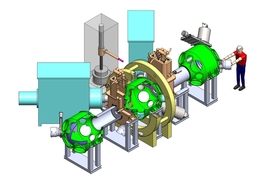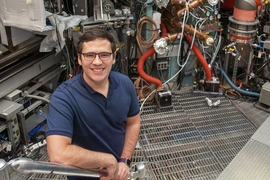The promise of fusion energy has grown substantially in recent years, in large part because of novel high-temperature superconducting (HTS) materials that can shrink the size and boost the performance of the extremely powerful magnets needed in fusion reactors. Realizing that potential is a complex engineering challenge, which nuclear science and engineering student Erica Salazar is taking up in her doctoral studies.
Salazar works at MIT’s Plasma Science and Fusion Center (PSFC) on the SPARC project, an ambitious fast-track program being conducted in collaboration with MIT spinout Commonwealth Fusion Systems (CFS). The goal is development of a fusion energy experiment to demonstrate net energy gain at unprecedentedly small size and to validate the new magnet technology in a high-field fusion device. Success would be a major accomplishment in the effort to make safe, carbon-free fusion power ready for the world’s electrical grid by the 2030s, as part of the broader push to control climate change.
A fundamental challenge is that fusion of nuclei takes place only at extreme temperatures, like those found in the cores of stars. No physical vessel can contain such conditions, so one approach to harnessing fusion involves creating a “bottle” of magnetic fields within a reactor chamber. To succeed, this magnetic-confinement approach must be capable of containing and controlling a super-heated plasma for extended periods, and that in turn requires steady, stable, predictable operation from the magnets involved, even as they deliver unprecedented levels of performance.
In pursuit of that goal, Salazar is drawing on knowledge gained during a five-year stint at General Atomics, where she worked on magnet manufacturing for the ITER international fusion reactor project. It, like SPARC, uses a magnetic-confinement approach, and Salazar commissioned and managed the reaction heat treatment process for ITER’s 120-ton superconducting modules and helped design and operate a cryogenic full-current test station.
“That experience is very helpful,” she notes. “Even though the ITER magnets utilize low-temperature superconductors and SPARC is using HTS, there are a lot of similarities in manufacturing, and it gives a sense of which questions to ask. It’s a situation where you know enough to understand what you don’t know, and that’s really exciting. It definitely gives me motivation to work hard, go deep, and expand my efforts.”
A central focus of Salazar’s work is a phenomenon called quench. It’s a common abnormality that occurs when part of a magnet’s coil shifts out of a superconducting state, where it has almost no electrical resistance, and into a normal resistive state. The resistance causes the massive current flowing through the coil, and the energy stored in the magnet, to quickly convert to heat in the affected region. That can result in the entire magnet dropping out of its superconducting state and also cause significant physical damage.
Many factors can cause quench, and it is seen as unavoidable, so real-time management is essential in a practical fusion reactor. “My PhD thesis work is on understanding quench dynamics, especially in new HTS magnet designs,” explains Salazar, who is advised by Department of Nuclear Science and Engineering Professor Zach Hartwig and started engaging with the CFS team before the company’s 2018 formation. “Those new materials are so good, and they have more temperature margin, but that makes it harder to detect when there’s a localized loss of superconductivity — so it’s a good position for me as a grad student.
“I hope to answer questions like, what does the quench look like? How does it propagate, and how fast? How large of a disturbance will cause a thermal runaway? With more knowledge of what a quench looks like, I can then use that information to help design novel quench-detection systems.”
Addressing this type of issue is part of the SPARC program’s strategic transition away from “big plasma physics problems,” says Salazar, and toward a greater focus on the engineering challenges involved in practical implementation. While there is more to be learned from a scientific perspective, a broad consensus has emerged in the U.S. fusion community that construction of a pilot fusion power plant should be a national priority.
To this end, the SPARC program takes a systemic approach to ensure broad coordination. As Salazar notes, “to devise an effective detection system, you need to be aware of the implications within the overall systems engineering approach of the project. I really like the way the project teams are designed to be fluid. Everyone knows who’s working on what, and you can sit in on meetings if you want to. We all have a limited amount of time, but the resources are there.”
Salazar has helped the process by starting a popular email list that bridges the CFS and MIT social worlds, linking people who would not otherwise be connected and creating opportunities for off-hours activities together. “Working is easy; sometimes the hard part is making sure you have time for personal stuff,” she observes.
She’s also active in developing and encouraging a more-inclusive MIT community culture, via involvement with a women’s group at PSFC and the launch of an Institute-wide organization, Hermanas Unidas, for Latina-identifying women students, staff, faculty, and postdocs.
“It’s important to find a community with others that share or value similar cultural backgrounds. But it’s also important to see how those with similar backgrounds have done amazing things professionally or academically. Hermanas Unidas is a great community of people from all walks of life at MIT who provide mutual support and encouragement as we navigate our careers at MIT and beyond,” explains Salazar.
“It’s wonderful to learn from other Latina faculty and staff at MIT — about the hardships they faced when they were in my position as a student or how, as staff members, they work to support students and connect us with other great initiatives. On the flip side, I can share with undergraduates my work experience and my decision to go to graduate school.”
Looking ahead, Salazar is encouraged by the growing momentum toward fusion energy. “I had the opportunity to go to the Congressional Fusion Day event in 2016, talk to House and Senate representatives about what fusion does for the economy and technologies, and meet researchers from outside of the ITER program,” she recalls. “I hadn’t realized how big and expansive the fusion community is, and it was interesting to hear how much was going on, and exciting to know that there’s private-sector interest in investing in fusion.”
And because fusion energy has such game-changing potential for the world’s electrical grid, says Salazar, “it’s cool to talk to people about it and present it in a way that shows how it will impact them. Throughout my life, I’ve always enjoyed going deep and expending my efforts, and this is such a great area for that. There’s always something new, it’s very interdisciplinary, and it benefits society.”









